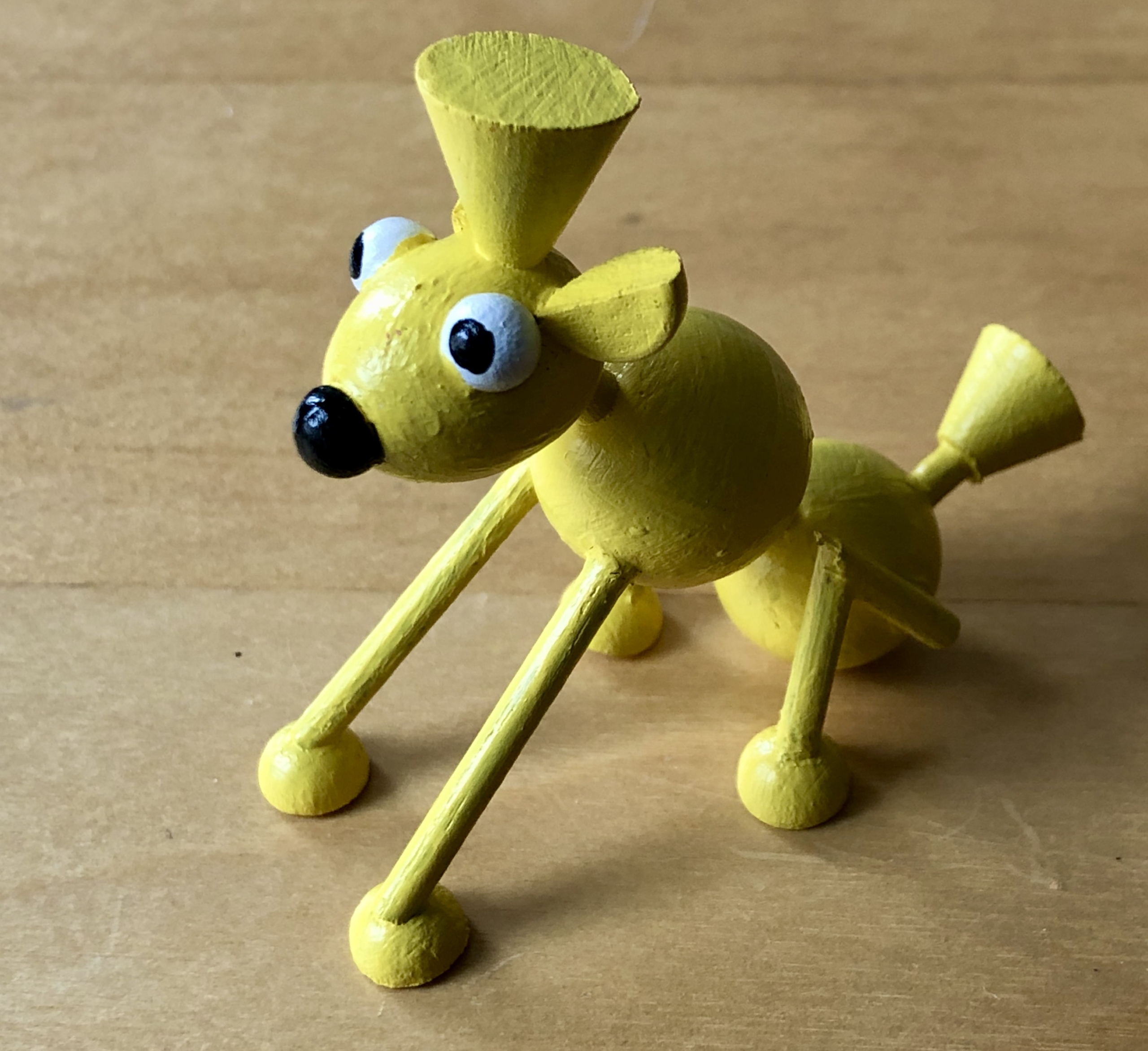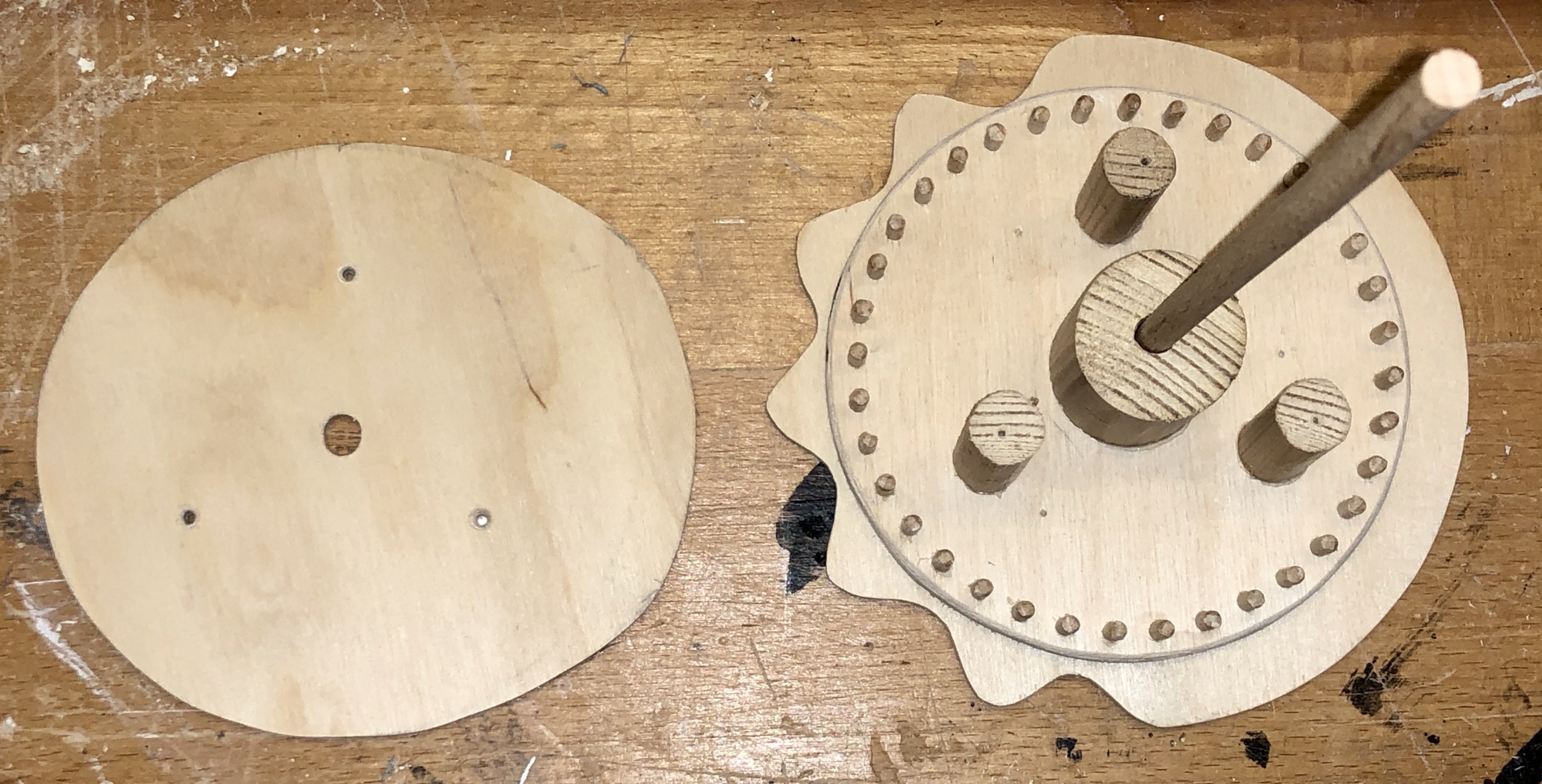Teatime

What was the creative brief?
As an Englishman in Berlin I am naturally a staunch defender of English culture, so I aim to sell the benefits of teatime to the pagan Germans who much prefer coffee! When two chatty friends get together, the benefit of having to drink tea is that while one is drinking their delicious tea, the other can chat and vice versa. The more vivacious the chat the better, so waggling head & hair and dangling earrings are a must.

Dangly earrings are a must
What’s the technical brief?
I like the idea of cams controlling things, but as I live in a small flat I see a drawback in the size of the base needed to accommodate cams which turn around a horizontal axis. I wondered whether arranging cams to turn around a vertical axis is feasible and whether the resulting base would be more compact.

This simple illustration shows the 2 options. At first sight the vertical bearing option looks distinctly flatter.
- With a horizontal bearing, as the cam turns, the cam follower is pressed onto it by gravity. As the edge of the cam moves up or down, the follower moves with it, or follows it.
- With a vertical bearing, gravity stubbornly remains a vertical force, so some other force X is needed to keep the follower in contact with the cam. It does however mean that several followers could share the same cam with a “phase” difference depending upon how far apart they are, angularly speaking.
Force X could be a spring, or we could use a piece of suitable routed string attached to a weight to pull the follower against the cam, thus bending gravity to the required angle. The angle of rotation of the handle should also be left to the user, so the cams should be “bidirectional”. The base should be as open as possible, so that you can see “the works”.
Additional ideas which came while making
The bearing for the cams became the leg for a table.
As the cam is in the centre of the base and the two figures are at the rear, the empty space at the front begged for something to fill it, so each of the friends has space for their dog which, as we know, always looks startlingly similar to its owner.

Small dog which is strikingly similar to its owner
The table rotating seemed to make no contribution to the narrative of the piece, so I almost stopped it from turning, but then I thought that it would make a splendid carousel for someone small enough to enjoy it, so that’s what it became, a tiny subplot within the bigger story.

A tiny subplot within the bigger story
Gears
The cams will turn in the horizontal plane, around a vertical axis, but the crank for users to turn will rotate in a vertical plane, around a horizontal axis. Pin gears seem like a good idea, a small one with 8 pins for the crank and a large one with 36 pins to drive the cams.

The two pinwheel gears

The pinwheel gears engaging
For a smoother motion, (after I took this photo) I folded a piece of sandpaper into a V-shape and chamfered the tops of two of the pins at a time in the large wheel. This is not needed for the small wheel.
Cams
Each figure has two moving parts – the mouth and the arm which lifts the tea cup. As good friends they take turns to speak and while they are not speaking, that’s the opportunity to have a slurp of tea. I decided to just use two cams. Each figure is driven by the same two cams but with a 180 degree offset. While one figure is chatting the other one is slurping and vice versa.

Two cams
In the above picture the left sort of egg-shaped cam is responsible for lifting the arms, the right cam for opening the mouths. When not chatting (the wavy bit) the mouth is held open to await a slurp of tea. Note that there are no abrupt steps in the shape of the cams here to make sure that it will work in both directions.
Followers
There are 4 followers mounted on levers which are pivoted at the front of the base, two for the lower cam and two for the upper cam. In the photo you can see the pivot at the left, the follower in the middle with a plastic ring to cut down friction, and at the right the part which drives the mechanism mounted on the rear wall.

Two follower levers
In this photo of the base you can see two followers with small springs to keep them in contact with the cams.

Base with two follower levers & springs
The rear wall mechanism

Changing the direction of motion
As the lever to which the follower is attached moves, it in turn moves this small mechanism, which has the effect of changing a horizontal motion into a vertical one. As the lever moves out it turns the triangularish piece of wood around its axis at the bottom. The row of small holes in the side are to take the vertical brass rod which moves the model. Unsure as to how much movement was needed, I could thus choose a hole and shorten or lengthen the movement by trial and error. This mechanism is repeated four times for four followers.
The tea drinkers

Half of a 40 mm wooden ball serves nicely as hips.
The figures are assembled along a piece of 8 mm dowel which is fixed into the seat. This means that they are adjustable. I left the knee hinged on a piece of 3 mm dowel until I was happy with the pose, only then gluing it. Half of a 40 mm wooden ball serves nicely as hips.

A whole wooden ball makes a good torso
One of the arms is hinged on the body to lift the cup of tea. The other arm is fixed to carefully hold the saucer.

A few wooden eggs & balls serve as the head and hairdo
The jaw is fixed to the 8 mm dowel and the head is then hinged onto the jaw. This means that the whole head moves when the figure is speaking/drinking tea, causing the earrings to swing about most satisfactorily. The eyes and nose are removeable to make painting easier before gluing them in place.

The head is hinged onto the fixed jaw for maximum waggle
Hands and teacup

Carefully hinged woodwedge teacups
The hands are carved from lime wood with the smallest finger slightly lifted. When the arm lifts, the protruding pinkie then makes that elegant gesture so typical of polished tea drinkers. Of course the teacup must stay horizontal to make sure that nothing gets spilled so it is hinged on a bit of brass rod.

The brass rods in place
Lessons learned
I ended up with quite a compact base so it was worthwhile turning the cams sideways. Precision seems to be more important like this however, so I had to take great pains to keep the two cams parallel to one another as well as to the box. The spacing between the two pin wheels also had to be just right for smooth operation. Fortunately, I could adjust that a bit via the thickness of the washer underneath the cam assembly. When I was almost done, I decided to use what I had intended to be a collar as a waist instead. Happily, that just meant changing the order of the bits on the 8 mm dowel. The figures look much more stylish like that. When testing the movement, I decided that the mouth was chattering too quickly, so I made a new cam from 3 mm plywood to slow things down a bit. I tried to resist gluing parts together for as long as possible to keep my options open. That is a delicate balancing act. While things are not fixed the precision wobbles and occasionally pieces tumble all over the place and have to be carefully collected. Once glued it can be hard to take things to pieces again to change this and that.
Youtube link https://www.youtube.com/watch?v=COTnQGcVq34
